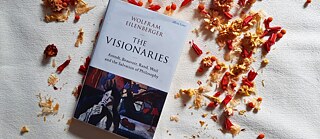Wolfram Eilenberger
The Visionaries

Intellectually stimulating and thematically rich: Wolfram Eilenberger’s The Visionaries is a collective biography of four women who helped to shape twentieth-century philosophy and literature, a book that will appeal to readers of Francesca Wade’s Square Haunting.
In 1933, the world seemed balanced on a knife-edge. Hitler’s accession to power, the horrors of the Holodomor, the displacement and exile of thousands across Europe, the slow creep of totalitarianism. It was the beginning of a decade of violence and terror, and many of the century’s brightest minds wondered where it would end.
Held within the framework of a single decade, ‘one of the darkest in Europe’s history’, The Visionaries is a collective biography of four formidable writers and thinkers: Simone de Beauvoir, Hannah Arendt, Ayn Rand and Simone Weil. The fact that they were all women is, of course, no accident – the book seems conceived as a counterpart to Time of the Magicians, Eilenberger’s group portrait of Benjamin, Heidegger, Cassirer and Wittgenstein – yet questions of gender and women’s social status seem rather secondary here. Instead, Eilenberger focuses on key philosophies and interests, drawing out the way in which the world shaped each woman and, in turn, how they tried to impact it.
Pondering not just the geopolitical situation but age-old existential questions, The Visionaries can thus be read as a primer of sorts, an introduction both to a period of history and four overlapping yet distinct streams of thought. Similar approaches have been popular lately – notably Square Haunting, Francesca Wade’s elegant study of five twentieth-century women writers, or Clare Mac Cumhaill and Rachael Wiseman’s sparky Metaphysical Animals, which also examines the lives of four women philosophers. For anyone keen to get an overview and perhaps find a subject to pursue in more detail, this is an appealing way to begin, and The Visionaries does indeed open up numerous avenues for further exploration. A light impression, however, it is not: Eilenberger’s writing has a distinctly academic bent. Just as Beauvoir, Arendt et al. found themselves facing unprecedented situations, so too are we expected to grapple with them intellectually, a reading experience that demands patience but yields great rewards.
One of these is increased familiarity with the strong voice of Simone Weil. Perhaps the least known of the four women – Eilenberger concludes by encouraging us to seek out her work – the diminutive philosopher and activist lived her short but intense life according to a strict moral code, fought briefly in the Spanish Civil War and later became a mystic. With the help of plentiful quotations, The Visionaries builds a sense of her and each woman’s personality – though Ayn Rand, the Russian American author whose works included The Fountainhead, can sometimes feel short-changed. This is perhaps inevitable: there is an immense amount of material to be condensed for each woman, let alone all four of them, and while Eilenberger rises to the challenge, he can occasionally seem impatient to move on.
That said, how else might we get a sense of the frantic pace at which these women thought and wrote? The Visionaries’ chop-and-change structure, which jumps from one life to the next in a series of short sections roughly grouped by year, can take some getting used to, but ultimately serves its purpose. In Shaun Whiteside’s sharp translation, Eilenberger’s prose is nothing if not rich, often narrated from a close third-person perspective that seeks to get right into its subjects’ minds and thought processes. A framework that supports reading in bite-sized chunks is therefore very welcome.
Concluding with a brief ‘Coda’ that covers the period after 1943, there is a sense on reaching the end of The Visionaries that we’ve only just scratched the surface. A fascinating insight into brilliant minds – and a guide, perhaps, to how we might meet the equally real and frightening events of the modern world – this is an exacting and informative work that rewards the patient reader and encourages further thought.
ABOUT THE AUTHOR

The article was first published in the dossier Book Blog: Literary Tastings by Goethe-Institut Glasgow.